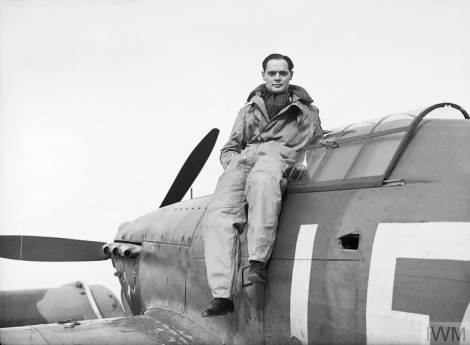Douglas Bader
Second World War

Douglas Bader was one of the RAF’s most famous fighter pilots during the Second World War. His story proved inspirational to countless people, both during and after the war. Born 21 February 1910 in London, Bader was awarded a scholarship to St Edward’s School in Oxford. This was followed by a place at RAF College in Cranwell, where he thrived at sports, captaining the rugby team and becoming a champion boxer.
In 1930, Bader was commissioned into the RAF, where he was posted to No. 23 Squadron at Kenley. Developing a talent for aerobatics, Bader performed in the RAF Display at Hendon in 1931. On 14 December 1931, tragedy struck when Bader crashed at Woodley aerodrome. He suffered life-changing injuries, having both of his legs amputated. Within just six months of the accident, Bader learned to walk unaided on artificial legs, and soon set his sights on learning to fly again.
Despite meeting the RAF’s requirements, however, a medical board ruled that he was unfit to continue as a pilot. Leaving the RAF in 1933, Bader found work with the aviation department of the Asiatic Petroleum Company (later Shell). When the Second World War started, Bader rejoined the RAF and was posted to No. 222 Squadron. He was soon promoted to Squadron Leader at No. 242 Squadron.
On 8 August 1941, Bader was shot down and kept a prisoner of war. He remained a prisoner of war until April 1945, making several escape attempts. After the war, Bader briefly served as Group Captain and took command of first the Fighter Leaders School and second the North Weald Fighter Sector. On 15 September 1945, he led the first Battle of Britain flypast.
In 1946, Bader finally left the RAF for good and returned to Shell, where he flew the company’s aircraft around Europe, the Middle East and Asia. He went on to become Managing Director of Shell Aircraft Ltd, retiring in 1969. In 1956, the film Reach for the Sky, based on Bader’s life, was released and increased his fame.
Bader dedicated a great deal of his time to working with and fundraising on behalf of disability groups and charities. He often paid surprise visits and wrote inspiring letters to amputees, becoming an inspiration to both the disabled and able-bodied. In 1982, he died suddenly, aged 72. Bader’s wartime contributions were recognised with several awards, including a DFC and a DSO. His wider contribution to society was recognised with a CBE in 1956 and a knighthood in 1976; both were awarded for his services to the disabled. The Douglas Bader Foundation was opened in his memory in 1982.




